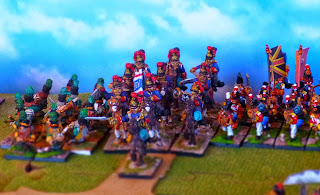Hello!
If you are just catching up here the links to
and
To spare you the suspense...
...you may be assured that the web of history remains intact despite my best efforts.
The end of the battle will be presented in photos below but first a word about the wherefore and such like.
As many have written, D'Erlon's deployment was too close to allow following battalions room to react to the head of each brigade having been run down by cavalry. But that is not all there is to it and D'Erlon's deployment did what it was intended to. Bear with.
It was only the closeness of the deployment that let me take the ridge in the first place. As each lead battalion was worn down it was an easy matter to bring fresh troops to the front. This in turn made it impossible for the Allies to hold the hedge for French numbers in a very short span of time were just too great.
No other deployment would have allowed reserves to have been brought up so quickly.
The charge of the heavies occurred exactly when it needed to in order to catch the heads of the French brigades at a great disadvantage.
What steps might have been taken to minimize the damage? As some have suggested Donzelot and Marcognet may have held their 2nd Brigades back to form a back stop if you will. These battalions would have had time to form square and provide a nucleus around which the other troops could rally.
However this presupposes that D'Erlon knew that a single brigade from each division would have been able to reach the ridge line as Bourgeois had and then been able to hold until relieved by a second line. IMO that would have been a bit of a gamble and the Count could easily have been pilloried after the fact for not having committed sufficient troops to the initial assault,
The one variable that I introduced in this situation was of no avail to the French cause. Keeping the 1st and 4th cuirassiers fresh did not change the outcome at all. A proper general may well have been able to use them to better advantage of course. As it was the field was too crowded with troops, La Haye Sainte smack dab in the way, and the threat of two heavy cavalry regiments bearing down on them made the cuirassiers irrelevant to the fate of the infantry assault.
Well at least the game was fun to play. Fast paced and no head smack moments and nothing illogical reared its ugly head : )
Now I have to put all those figures away...
 |
| Overview of the field as the French near their high water mark, |
 |
| The 62nd exchanges volleys while the 21st wavers. |
 |
| Bourgeois and Donzelot about to break the Allied line. |
 |
| Looming defeat from the Allied perspective. |
 |
| The cavalry arrives just in the nick of time. |
 |
| The Household Brigade Who is that leading the Dragoon Guards? |
 |
| The Blues! |
 |
| Charge of the Royals. |
 |
| Lead French battalion routs! |
 |
| Slaying all the way... |
 |
| Charge of the Greys |
 |
| The onslaught is unstoppable |
That's all for now.
As always thanks for stopping by!





















